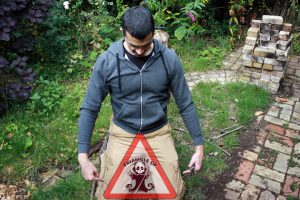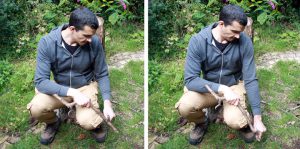Knife Safety: 7 Tips to Keep You Safe
Posted by jack ma on
Knives are essential tools to have ready at hand during any outdoors trip, whether you are out camping, bushcrafting or you simply keep one ready to use. Whether you use a survival knife or a pocket knife, all knives have one thing in common: they are dangerous.
Regardless of the type of knife you are using, it is important to keep in mind a few safety measures that could mitigate your chances of getting hurt during a trip, or at any given moment. To help you learn some basic knife safety rules, we have listed a few practical tips and tricks that will help you to decrease the chance of getting hurt while using a knife.
1. Always Use a Sharp Knife
This is the one rule of thumb about knife safety that you should always keep in mind. Even though a sharp knife is dangerous, a blunt knife can be just as dangerous if not more.
As blunt knives do not cut as easily, it is likely that a person would employ more force to achieve a cut. If the knife happens to slip, the consequence could be a disastrous accident as a result of losing control over the tool. If you cut yourself with a sharp knife, although it will still be painful, the knife would cause a clean would that would be easier to treat and stitch if necessary.
2. Keep Your Knife Sheathed
The blade of a knife must always be protected and sheathed to avoid any careless accidents, such as sitting or standing on an uncovered blade. While most people do take care of transporting their knife in a sheath, once they pull it out so they can put it to use, they often forget to store it again. If the knife gets misplaced while it is unsheathed, this could be an accident waiting to happen.
Be wary to not walk with your knife exposed especially outdoors, where you could easily trip over a branch or with the uneven terrain. Falling with an unsheathed knife could expose you to getting a fatal wound. Avoid clumsy accidents and remember to put your knife back into its sheath after using it, even if you will be using it shortly after. When it comes to using knives, it’s always better to be safe than sorry and act preventively.
3. The Blood Circle and The Triangle of Death
While using a knife, you must ensure that no one is at arms reach. The circle that you can make while reaching out at your chest’s level is called the Blood Circle. If a person is found within that circle, you must abstain from using the knife until the person is away and out of the circle’s reach to ensure their safety.
However, it is not just other’s safety you should care about. In order to keep yourself safe while carving or cutting, you must avoid cutting between what is known as The Triangle of Death. The area between your groin down to the knees forms this so-called triangle, which is dangerous as your femoral arteries are found on your legs. If cut here, you could bleed out within minutes.
4. Grip the Knife Tightly
To avoid slips, grip the knife with a fist grip similar to how you hold a hammer or an ax. Make sure that your thumb or fingers don’t interfere with the blade area and stay within the parameters of the handle.
To not lose your grip easily, avoid using your knife while you are tired. Handling a knife while you are not in your full headspace could leave room for clumsy mistakes and you could easily lose your grip on the knife.
5. Keep a First Aid Kit at Hand
Although any outdoors experience should already include a first aid kit as a basic necessity, you want to make sure you don’t leave yours at home if you will be using a knife. But having a first aid kit ready to go is not the only thing you need to have ready.
Learn how to treat minor injuries in case of emergency and check your first aid kit every once in a while so that you know if you need to replace something from your kit to use in the future.
6. Cut Away from Your Body
While cutting or carving, not only do you need to worry about clearing out the Blood Circle and being careful of The Triangle of Death, but you also need to make sure you always cut with the knife facing away from you.
There are techniques such as the chest lever, where you hold the knife tightly and only pull the wood away from you. Always maintain the knife static and be sure to only move the piece of wood. Let the motion of the piece that you are cutting take care of itself and cut away. Do not cut towards yourself or in the direction of your body.
7. Give Your Knife Maintenance
There are a few things that can be done to maintain a knife in fit condition. The first is to always dry your knife after washing it or exposing it to liquids. Although some blade materials are more resistant to liquids, none of them are completely immune to forming rust. Cutting yourself with a rusty knife will expose you to tetanus, so always keep your knife dry.
Although you have heard previously that a dull knife is a dangerous knife, we can also tell you that a dirty knife, too, is a dangerous knife. This is especially true when it comes to pocket knives, as lint in your pocket can block the pivot and locking areas. This can cause a folding knife to be slower or more difficult to open, which could lead to injury while exerting force to open it or operate it.
As an additional piece of advice, remember to lubricate your knife occasionally in order to prevent rust and also to keep all moving parts of a knife functional, if there are any. Some lubricants are made to attract less pocket lint to help you keep your knife clean, while others are food-safe in case you will be using your knife for food.
Respect the Tool
Only use a knife when it is absolutely necessary to use one. There are certain tasks that can be accomplished without a knife, such as breaking or snapping a branch with your hands or by putting it at an angle and stepping on it instead of attempting to cut or chop it.
Being oblivious to the harm this tool could cause can lead you to being careless and clumsy with your knife. Knives are not toys and should therefore be treated with respect and awareness. Understanding the power of your tool will always keep you safe above all and help you to remember these safety tips that could make the difference between safe usage and a life-threatening accident.



